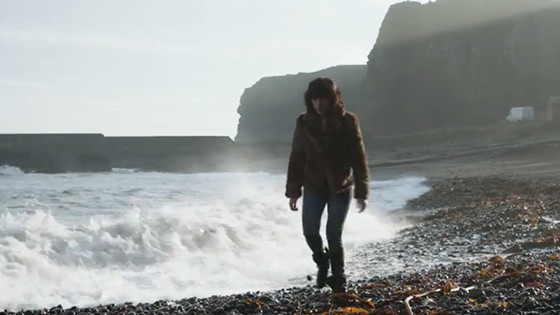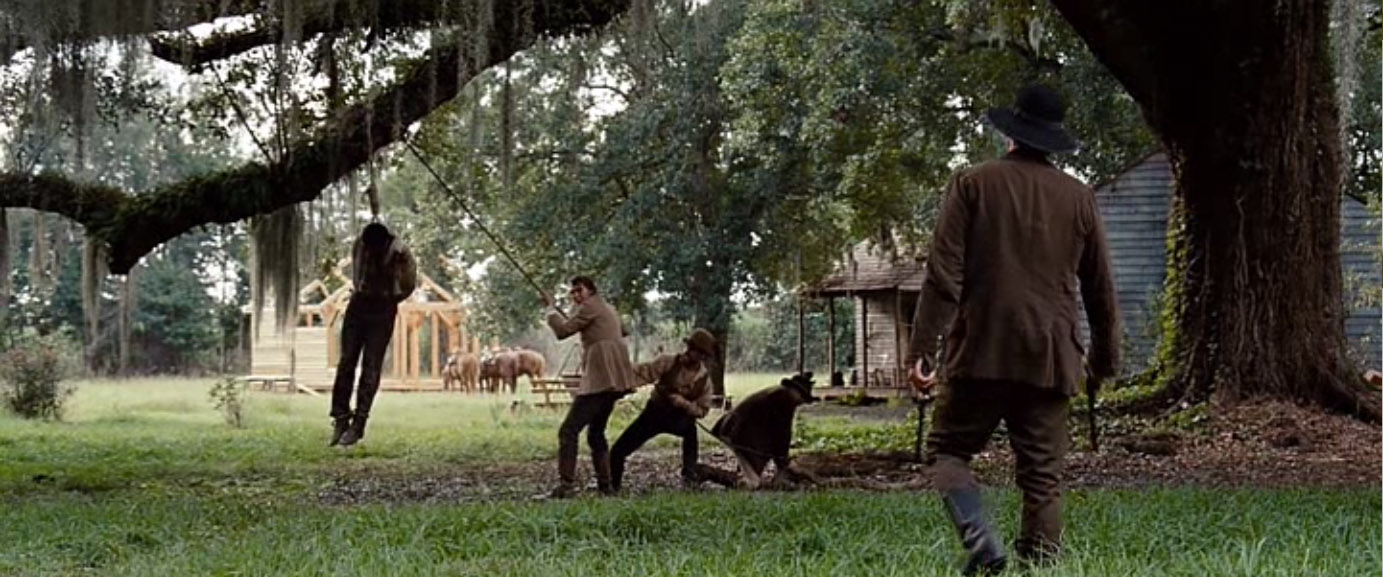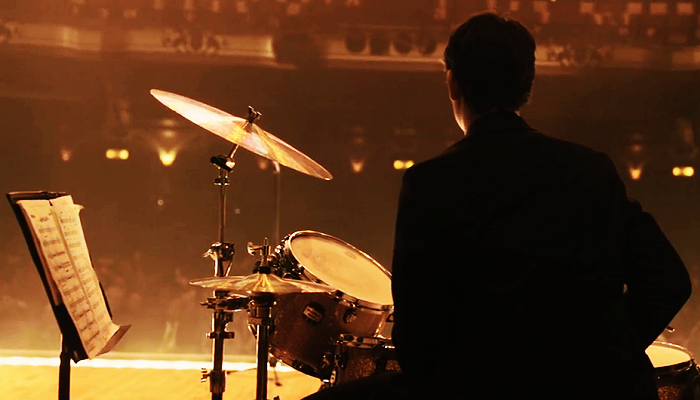8. The Apple’s Journey in Once Upon a Time in Anatolia

It is amazing how some of the most memorable and impactful scenes can be ones that have no consequence to the plot or narrative whatsoever. Having been on the road for hours, a group of officers grow frustrated when they are given wrong directions to a buried corpse by a convicted murderer in their custody. They now face the prospect of another wild goose chase and one officer takes his anger out on the killer, only to be taken to one side and scolded for not being more professional.
Meanwhile, another officer shakes an apple tree in the hopes of finding a snack. A dozen apples fall and the camera follows one as it rolls down the hill. The conversation between the officers continues to play on an audio level, but the apple itself remains as the focus of the camera’s and audience’s attention. The natural flow and progression of the scene creates an almost Tarkovskian atmosphere, focusing on the beauty of a tiny detail that can be taken as a deep metaphor or just at face value.
7. Into the Sandstorm in Mad Max: Fury Road

When George Miller returned to the post-apocalyptic action franchise that put his name on the map, expectations were fairly high and by this point it seems as though virtually no one is denying that it was a resounding success, pulling in great numbers at the box office as well as numerous awards. It is difficult to pick a single scene that stands as the best of the film, as it is essentially one giant action set piece after another, but the best one might just be that.
Under pursuit from Immortan Joe’s forces including a captured Max Rockatansky, Furiosa tries to shake them by driving through the heart of a massive sandstorm. It’s here that Miller’s talents as a visual storyteller come to fruition, the sheer size and scale of the event really is felt and as the characters plough towards it, there is an undeniable sense of dread as they enter the swirling whirlwind of destruction. The vibrant colours and striking images all attribute the sheer awesomeness of the scene.
Once inside the storm though, there is a quiet moment of what one could almost call tranquillity. As death and fire rains down from the sky, the camera focuses on the lone car driven by Nux that Max is tied to, providing us with a strict first person perspective of the ensuing carnage.
But where some directors would make an effort to explicitly show the destruction and mayhem in all its glory, Miller allows the audience to see only what Max sees, when something explodes but is obscured by dust, it remains that way, there is no gratuitous close up or shift of perspective, we are sticking firmly to the character we know and seeing his own viewpoint of the world which, for all the madness and chaos that is present, gives the scene an oddly intimate feel.
6. The Baby on the Beach in Under the Skin

Jonathon Glazer’s science fiction, horror masterpiece features several outstanding scenes, but arguably the best and most haunting of all comes from a scene on the beach. Like the rest of the film, it’s mysterious, layered and almost hypnotic in its slightly surreal nature, but unlike some of the other striking scenes, this one maintains a sobering grip on reality to remind the audience of just how horrifying this situation is.
As Scarlett Johansson’s nameless, disguised alien stalks the coast of Scotland, she comes across a surfer and begins to inquire as to why he is in the area. Having already seen what she has done with the other men she has struck a conversation with, there is a certain amount of tension in this relatively light conversation. But then things turn down a much darker road as a storm blows in, a couple are struggling to rescue their pet dog from the waves, only to be washed away themselves.
As the tragedy is unfolding, the surfer runs off to help them but Johansson does nothing in response, if anything confirmed her complete and utter detachment from human emotions and otherworldly nature, then this was it.
Then if anyone needed any reminding the worst is yet to come, as she takes the chance to knock the surfer unconscious, leaving the couple’s infant child crying on the beach. To see her so clearly reject what any other human could not ignore is a disturbing and haunting image, and the most effective way to convey the overall theme of the film.
5. The Hanging in 12 Years a Slave

Powerful seems like the only word one can use to accurately describe Steve McQueen’s film about Solomon Northup’s memoir, recounting the twelve years he spent in slavery after being kidnapped from his home and sold from plantation to plantation. In this particular scene, Northup, having defended himself against Paul Dano’s drunken and abusive plantation foreman, is hung by the neck from a tree branch, just low enough to let his feet barely touch the muddy ground and prevent him from being strangled to death.
There are many haunting aspects to this scene. The first is how McQueen stays focused on Chiwetel Ejiofor’s struggling and writhing body as he desperately tries to stay steady in this precarious position.
Then there is just how long the scene seems to go on, two and half minutes is not a long time in most circumstances, but here McQueen uses the time to make you feel the passage of an entire day as if you had just lived through it, you feel the length of time that Northup has had to endure this punishment and you are willing for some sort of release.
But perhaps even more disturbingly is how McQueen provides glimpses of regular life as it contuse around Northup’s hanging body. People go about their everyday activities and act as if nothing is out of the ordinary, which immediately confirms to the viewer that in this world, this event is not out of the ordinary at all, that it is in fact a normality.
One of the most striking images comes from a close up of Ejiofor’s pained expression which is partly occupied by children playing in the background, a haunting juxtaposition.
4. The Hotel Argument in Before Midnight

The final chapter of Richard Linklater’s epic and decade spanning love story is the least romantic of the three. At times it’s a sober reminder of the effects of time and nowhere is that more evident than a gruelling twenty minute long argument. Not only is this the first real time we’ve seen them argue, but if any viewer can recall back to the first film in which the young pair witness a married couple arguing, then it will suddenly dawn upon them that Jesse (Ethan Hawke) and Celine (Julie Delpy) have become that arguing couple.
It is hard to think of another word for the scene other than brutal, because this is not just some little spat or even a heated debate, this is a full on verbal fight and nothing short of fisticuffs could make it more painful to watch. The fact that it’s a night of arranged romance gone south only makes things worse. But there is a lot to be admired in the scene beyond the emotional heft. Linklater’s direction captures the argument in the most truthful and honest fashion imaginable, tracking the characters through each verbal exchange.
The writing of the scene itself is also mightily impressive. The script was a collaborative effort between Delpy, Hawke and Linklater who all clearly have a love and admiration for these characters and therefore know just how to reflect their emotions consistently and accurately.
The intensity does not just came and go, it rises in phases before shimmering down only to burst forth yet again, as if sparked by a new motive. The scene allows us to have a deeper understanding of the story and gives a more impactful meaning to the characters relationships.
3. The Elevator in Drive

There are many impressive scenes throughout Nicholas Winding Refn’s neo-noir crime drama, but if one moment can be pointed to as the one that will undoubtedly have a lasting impact on anyone who sees it, it is the infamous elevator scene. With both the Driver (Ryan Gosling) and Irene (Carey Mulligan) stepping into an elevator, along with an enforcer whose intentions are clearly ill intended, the scene acts as an encapsulation of the film’s central theme, a man who wants to hide his violent past but is constantly dragged back into the world of criminals.
Winding Refn is able to make it obvious what is going through the Driver’s mind as this moment. As soon as he spots the gun beneath the enforcer’s jacket, he knows he has to act, but in doing so he will finally reveal himself to Irene. Before he does so, he pushes her to one side and kisses her.
The moment is staged in slow motion shot, where the noises of the outside world no longer matter, in an action that both the characters and the audience have wanted from the start of the film. To see them finally express their feelings for one another is a moment of transcendent beauty and the aesthetics of the scene only further help to convey that.
Then there is that single fleeting moment, just as they break apart where Irene’s face is more clearly illuminated, allowing both the Driver and the audience to catch one last clear look at her, the last time that she will see him in this light. When the violence does come, it is shockingly brutal, as the Driver smashes the enforcers head to a pulp.
To say that the violence is unnecessary is to miss the entire point, it needs to be especially brutal as both the audience and Irene are truly seeing the Driver for what he really is and not only that, the violence reflects the rage of a man who has sacrificed an entire life in an instant.
The fact that when the Driver turns back, Irene is already out of the elevator and distancing herself from him is heart-breaking. The loom of inevitable dismay from Gosling combined with the horror on Mulligan’s face is a clear sign of their absolute separation. Then final shot of the scene acts as a perfect ending, a close-up of the scorpion on the Driver’s back.
It represents the revelation of his true nature but is also a call back to the fable of the scorpion and the frog that was recounted earlier in the film. Some creatures must do what is in their instinct, whether they want to or not.
2. Drum Finale in Whiplash

When you think about films that used their final moments to reach a culmination and fulfill the needs and desires of both the main character and the entire audience on such a euphoric level, then Whiplash’s finale isn’t just the best of this decade, it stands as one of the best of all time.
Having endured the sadistic torment of his, some would say psychopathic and others would say motivational, teacher Fletcher (J.K Simmons) Andrew Neiman (Miles Teller) is able to perform a visceral jazz solo free from criticism, free from torment, finally gaining a victory over Fletcher and with an entire audience to watch.
The drum playing itself is excellently directed and performed. Despite being overshadowed by Simmons for a majority of the movie, this is where Teller really begins to shine, the intensity and passion of his character is perfectly captured here. Not only that, but this display of showboating talent is a moment for Whiplash to do what it does best by weaving the emotions of its protagonist with the expectations of the audience and this lengthy amount of showboating is the perfect finale for a film that does that repeatedly.
Not only that but the scene is so exquisitely edited, paced and composed with the moment of cathartic release being one of celebration as well as trepidation. But of course what elevates the scene even further is the underlying meaning behind it, for a while it may seem that Andrew has achieved a victory over Fletcher if you recall the original intent of the teacher to mould his student into his own creation of perfection, then this is pretty close to it.
It’s the consummation of their deadly relationship and by fulfilling it here, Andrew may have just sealed his fate forever. Haunting, rhythmic, kinetic and endlessly riveting, this scene is pure musical perfection.
1. Processing in The Master

Sometimes it’s a simple conversation that can be the most powerful scene of all and that is most definitely true when it comes to this crucial scene in Paul Thomas Anderson’s fifth film that is in the running to be labelled as his masterpiece, The Master.
It tells the story of Freddie Quell (Joaquin Phoenix), a World War II veteran struggling to adjust to a post-war society, who meets Lancaster Dodd (Philip Seymour Hoffman), a leader of a religious movement known as The Cause. Dodd sees something in Quell and accepts him into the movement. Freddie takes a liking to The Cause and begins traveling with Dodd along the East Coast to spread the teachings.
At one point in the film, Freddie is inducted into The Cause through a sequence known as processing, an intense interview in which the participant is forbidden from blinking and must answer every question truthfully. Not only is the dialogue itself brilliantly complex and thought provoking but the intensity behind the interview and the pacing of their conversation makes it absolutely thrilling.
Combining that with two immensely talented actors at the top of their game, Hoffman in his subtle yet commanding presence and Phoenix in his vulnerable but multifaceted state of mind and you have a complex game of cat and mouse, an intense character study and a philosophical take on society all in one scene.
One question can reveal hidden depth to Freddie’s character, another could break him down even further on an emotional level and another has the potential to spark a heated debate, anything is possible. But the way the conversation is structured really gives credit to PTA’s skill as a writer, as he expertly weaves the conversation through multiple threads that dip in and out of each theme, making it impossible to predict precisely where it will go.
But on top of all of this, you have Anderson’s direction that holds onto each shot for just the right amount of time, being able to focus on the intensity of the scene or lighten the tone when things get too serious. It really is a marvel of filmmaking.
Author Bio: Joshua Price considers himself more of a fan that happens to write near insane ramblings on movies and directors like Scorsese, Spielberg, Bergman, Kubrick and Lumet rather than an actual critic and other insane ramblings can be found criticalfilmsuk.blogspot.co.uk.